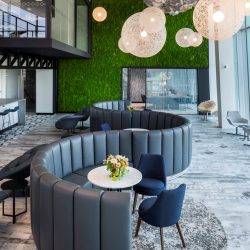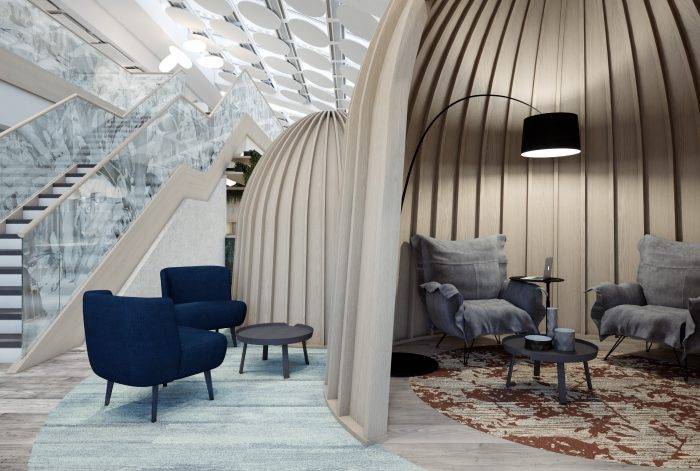 The idea of coworking is starting to resonate with a growing number of businesses and for a growing number of reasons. People new to the concept, or those who are aware primarily of its roots, may discover or retain a notion that it is a way for start-ups and freelancers to share space as a way of keeping down costs or networking with similar organisations. There is still a great deal of truth in this, given that the initial growth of coworking was based almost exclusively on the need for small tech and creative organisations to occupy space near to their larger clients, in precisely those urban enclaves that demand eye-watering rents and conventional leases.
The idea of coworking is starting to resonate with a growing number of businesses and for a growing number of reasons. People new to the concept, or those who are aware primarily of its roots, may discover or retain a notion that it is a way for start-ups and freelancers to share space as a way of keeping down costs or networking with similar organisations. There is still a great deal of truth in this, given that the initial growth of coworking was based almost exclusively on the need for small tech and creative organisations to occupy space near to their larger clients, in precisely those urban enclaves that demand eye-watering rents and conventional leases.
This is the main reason coworking’s roots are traceable to the city centre hotspots of London and New York, and why the idea then propagated most successfully in cities like Paris, Berlin, Tokyo and Melbourne.
[perfectpullquote align=”right” bordertop=”false” cite=”” link=”” color=”” class=”” size=””]This proliferation of spaces also indicates just how mainstream the idea has become, and not just in its traditional sectors and geographies[/perfectpullquote]
Quite how extensive the World’s network of coworking spaces has become is apparent from an interactive map published by the broker website coworking.com. Even allowing for the usual blurring of definitions of what constitutes a coworking space, this indicates remarkable growth for an idea for which we had no real word before 2005. There’s a good reason why this is an interactive map because the growth of the sector can only be determined as a snapshot.
This proliferation of spaces also indicates just how mainstream the idea has become, and not just in its traditional sectors and geographies. The shift will require a lot of adjustment in all of the various facets of the commercial property, workplace and facilities management sectors.
 Perhaps most importantly, occupiers are starting to address their real estate strategy and consequently a key element of their business model and organisation. Although larger organisations might not see coworking as a total alternative to the traditional model of occupying space, they now frequently see it as part of a workplace strategy.
Perhaps most importantly, occupiers are starting to address their real estate strategy and consequently a key element of their business model and organisation. Although larger organisations might not see coworking as a total alternative to the traditional model of occupying space, they now frequently see it as part of a workplace strategy.
One model they find attractive is flex and core in which the firm combines a longer-term lease with a traditional landlord for its core functions and to maintain an identity alongside membership with a flexible workspace operator to make it more agile and responsive to change and to foster new ventures.
This is the approach adopted by firms such as IBM and Phillips in Amsterdam to encourage innovation and draw new skills into the organisation. Similarly, firms can create coworking space in their own buildings to create a community of talent to which they would not normally have access.
There is a clear business case for this approach not only in terms of adding value to the business through agility, nurturing new business ideas and the acquisition of talent and knowledge, but also reducing capital expenditure significantly.
A similar model, known as city campus, allows a firm to expand rapidly and flexibly by growing into coworking spaces. Membership also allows them to access space from coworking providers in other geographies, essential for businesses looking to grow beyond their borders.
The commercial property sector’s response
The whole commercial property sector is having to reappraise its business models in light of the growth of coworking and the core and flex model. Our own company now sees constantly growing demand from providers, with around a quarter of our own rapidly growing business in the sector. Even for traditional clients, we are finding a growing need to apply the aesthetic and functional characteristics of coworking space to create the sorts of collaborative environments they need.
[perfectpullquote align=”right” bordertop=”false” cite=”” link=”” color=”” class=”” size=””]The forces that coworking has unleashed into the real estate sector are analogous to those with which we are familiar in retail, transport, entertainment and software[/perfectpullquote]
The forces that coworking has unleashed into the real estate sector are analogous to those with which we are familiar in retail, transport, entertainment and software. WeWork and its contemporaries are merely the latest pioneers in the mould of Amazon, Uber, Spotify, Netflix and Microsoft.
Just as it is now easy to buy services and products as and when they are needed, often on demand rather than a one-off, permanent purchase, so it will become with real estate. Firms will acquire the space they need – at least for some aspects of their business – with exactly the elements and services, they need, whenever and wherever they and their employees are.
Commentator and tech entrepreneur Antony Slumbers, the John the Baptist of this new era, has defined the most important characteristics of it in this way:
- Landlords move from being rent collectors to service providers
- The digital layer of the building is what makes it smart for end users
- The user’s experience of space defines the brand and the organisation’s value
- A great user experience needs a combination of great data, great tech and great people
- Workplace managers become the creators of experiences
These are all conversations we now routinely have with clients, as the principles and characteristics of the coworking movement define the way organisations view their workplaces, regardless of their strategy. It is based on a yearning for the best possible outcomes for the organisation and the people who work there. It’s about the bottom line but it is also about delivering a better experience of work for individuals. For them it answers the most pressing question of this new golden era for the workplace; when you can work from anywhere, how do you make the office the best place to work?
__________________________________________________
 Gary Chandler is the CEO of Fourfront Group. Images: LEO Nova North designed by Area.
Gary Chandler is the CEO of Fourfront Group. Images: LEO Nova North designed by Area.













April 3, 2019
Coworking and a new golden era for the workplace and the people who inhabit it
by Gary Chandler • Comment, Coworking, Workplace design
This is the main reason coworking’s roots are traceable to the city centre hotspots of London and New York, and why the idea then propagated most successfully in cities like Paris, Berlin, Tokyo and Melbourne.
[perfectpullquote align=”right” bordertop=”false” cite=”” link=”” color=”” class=”” size=””]This proliferation of spaces also indicates just how mainstream the idea has become, and not just in its traditional sectors and geographies[/perfectpullquote]
Quite how extensive the World’s network of coworking spaces has become is apparent from an interactive map published by the broker website coworking.com. Even allowing for the usual blurring of definitions of what constitutes a coworking space, this indicates remarkable growth for an idea for which we had no real word before 2005. There’s a good reason why this is an interactive map because the growth of the sector can only be determined as a snapshot.
This proliferation of spaces also indicates just how mainstream the idea has become, and not just in its traditional sectors and geographies. The shift will require a lot of adjustment in all of the various facets of the commercial property, workplace and facilities management sectors.
One model they find attractive is flex and core in which the firm combines a longer-term lease with a traditional landlord for its core functions and to maintain an identity alongside membership with a flexible workspace operator to make it more agile and responsive to change and to foster new ventures.
This is the approach adopted by firms such as IBM and Phillips in Amsterdam to encourage innovation and draw new skills into the organisation. Similarly, firms can create coworking space in their own buildings to create a community of talent to which they would not normally have access.
There is a clear business case for this approach not only in terms of adding value to the business through agility, nurturing new business ideas and the acquisition of talent and knowledge, but also reducing capital expenditure significantly.
A similar model, known as city campus, allows a firm to expand rapidly and flexibly by growing into coworking spaces. Membership also allows them to access space from coworking providers in other geographies, essential for businesses looking to grow beyond their borders.
The commercial property sector’s response
The whole commercial property sector is having to reappraise its business models in light of the growth of coworking and the core and flex model. Our own company now sees constantly growing demand from providers, with around a quarter of our own rapidly growing business in the sector. Even for traditional clients, we are finding a growing need to apply the aesthetic and functional characteristics of coworking space to create the sorts of collaborative environments they need.
[perfectpullquote align=”right” bordertop=”false” cite=”” link=”” color=”” class=”” size=””]The forces that coworking has unleashed into the real estate sector are analogous to those with which we are familiar in retail, transport, entertainment and software[/perfectpullquote]
The forces that coworking has unleashed into the real estate sector are analogous to those with which we are familiar in retail, transport, entertainment and software. WeWork and its contemporaries are merely the latest pioneers in the mould of Amazon, Uber, Spotify, Netflix and Microsoft.
Just as it is now easy to buy services and products as and when they are needed, often on demand rather than a one-off, permanent purchase, so it will become with real estate. Firms will acquire the space they need – at least for some aspects of their business – with exactly the elements and services, they need, whenever and wherever they and their employees are.
Commentator and tech entrepreneur Antony Slumbers, the John the Baptist of this new era, has defined the most important characteristics of it in this way:
These are all conversations we now routinely have with clients, as the principles and characteristics of the coworking movement define the way organisations view their workplaces, regardless of their strategy. It is based on a yearning for the best possible outcomes for the organisation and the people who work there. It’s about the bottom line but it is also about delivering a better experience of work for individuals. For them it answers the most pressing question of this new golden era for the workplace; when you can work from anywhere, how do you make the office the best place to work?
__________________________________________________